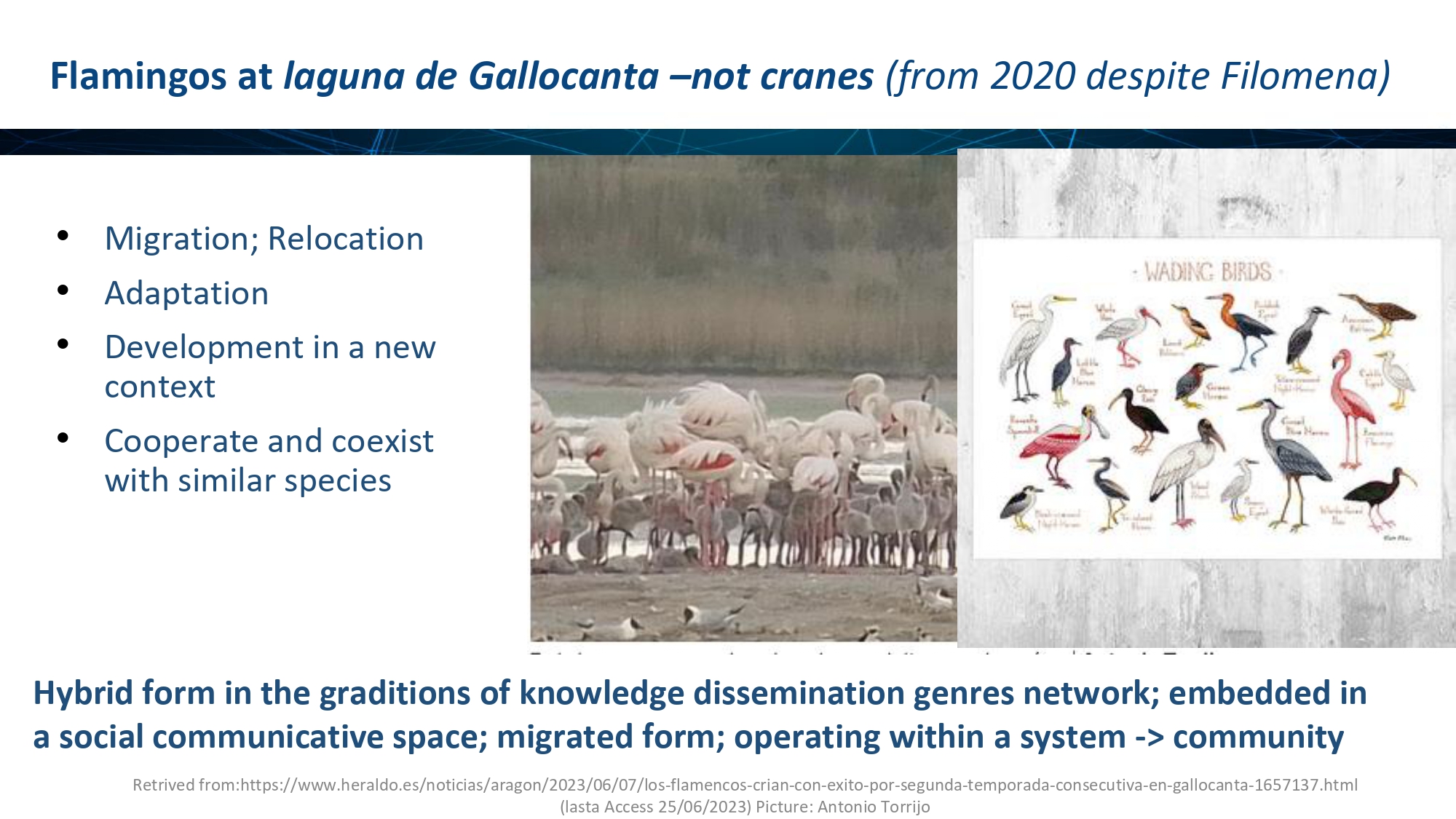AELFE 2023: Isabel Herrando explores genre and discourse practices in explainers

Isabel Herrando participated in the AELFE-LSPPC 2023 (European Association of Languages for Specific Purposes – Asia-Pacific LSP & Professional Communication Association) joint international conference, which was held in Zaragoza the days 28th-30th June 2023.
In her paper, titled “Exploring the genre and discourse practices of web-text explainers”, Isabel analysed 10 explainers from the website The Conversation, focusing on the rhetorical organisation and discourse strategies that this genre presents through their structure and through lexico-grammatical features. She also explored how credibility is built in explainers through hyperlinked texts and resources, since they bring readers to research papers and other trustworthy sources.
The full abstract of Isabel Herrando’s talk can be consulted as follows:
Exploring the genre and discourse practices of web-text explainers
The genre of written scientific popularizations has received considerable critical attention from the 1980’s (Myers, 1986; Gil-Salom, 2001; Giunchi, 2002; Calsamiglia & van Dijk, 2004; Herrando-Rodrigo, 2014, among others). Nowadays, the recontextualization of scientific knowledge plays a key role in the development of researchers’ professional careers (Luzón, 2013) and in the well-being of potential readers (Gotti, 2014; Turnbull, 2015). As Luzón (2022) points out, with the advent of web-mediated communication practices and their varied modes and media, the genre of explainers: “is being increasingly used on news websites and the websites of scientific organizations to make knowledge understandable by the wide public” (p. 98). Since researchers are facing the challenge of disseminating their work in that digital environment to a variety of audiences, LSP practitioners should investigate the discourse practices employed in the genre of explainers in order to help future graduates and scientists to develop the necessary literacies. Thus, this paper first analysis the rhetorical organization and discourse strategies of 10 explainers from the website The Conversation using Askehave and Swales (2001) approach to electronic genres -based on the rhetorical structure of information and lexico-grammatical features. Secondly, hyperlinked texts and resources are also studied to obtain an explicit account of what this paper considers one of the main purposes of explainers genre, that is, building credibility (Luzón, 2022). Results suggest that rhetorical structure delves around three moves (introduction, body and conclusion) and three sub-moves introduced by headings –codified as direct and indirect questions. Discourse practices include inclusive pronouns, engagement markers and simple lexico-grammatical choices that explain scientific terms and situations for the sake of understanding. Finally, the hyperlinks found should be considered markers of credibility as they lead the reader to writers’ research papers, experts on the field research papers, reliable institutional reports and other trustworthy web-texts. It could then be concluded that operationalizing the notion of credibility markers in web-text explainers may allow LSP practitioners to support emerging communication needs in the professions (Jones, et al., 2015).
References:
Askehave, I. & Swales, J. (2001). Genre identifications and communicative purpose: a problem and a possible solution. Applied Linguistics 22 (2), 195-212.
Calsamiglia, H. & Van Dijk T. A. (2004). Popularization Discourse and Knowledge about the genome. Discourse & Society 15 (4), 369-389.
Gil-Salom, L. (2000). El discurso de la ciencia y la tecnología: El artículo científico de investigación vs. El artículo de divulgación científica [The discourse of science and technology: The scientific research article vs the popular scientific article]. Revista Española de Lingüística Aplicada, 14, 429-452.
Giunchi, P. (2002). Information or Misinformation? `Translating´ Medical Research Papers into Web-posted Accounts. In G. Cortese & P. Riley (Eds.) Domian-specific English (pp. 271-293). Peter Lang.
Gotti, M. (2014). Reformulation and recontextualization in popularization discourse. Ibérica 27, 15-34.
Herrando-Rodrigo, I. (2014). A contribution to the study of writers’ self-representation: visible researchers, invisible writers, or how to make medical electronic popularizations trustworthy. Unpublished Doctoral Dissertation. University of Zaragoza, Spain.
Jones, R.H., Chik, A.& Hafner, C.A.(Eds.) (2015). Discourse and Digital Practices: Doing discourse analysis in the digital age. Routledge
Luzón, M. J. (2013). Public Communication of Science in Blogs: Recontextualizing Scientific Discourse for a Diversified Audience. Written Communication, 30(4), 428–457.
Luzón, M. J. (2022). ‘Coronavirus explainers’ for public communication of science: Everything the public needs to know. In A. Musolff, R. Breeze, K. Kondo, S. Vilar-Lluch (Eds.) Pandemic and Crisis Discourse: Communicating COVID-19 and Public Health Strategy (p.p. 72-97). Bloomsbury Publishing.
Myers, G. (1986). “The Social Construction of Popular Science: The Narrative of Science and the Narrative of Nature”. In G. Myers (Ed.) Writing Biology: Texts in the Social Construction of Science. Madison: University of Wisconsin Press. Turnbull, J. (2015). Knowledge dissemination online: the case of health information, in Bondi, M., S. Cacchiani & D. Mazzi (Eds.), Knowledge Dissemination In and Through the Media: Recontextualizing and Reconceptualizing Expert Discourse. (pp. 290-314). Cambridge Scholars Publishing.
